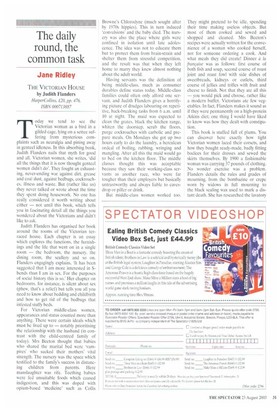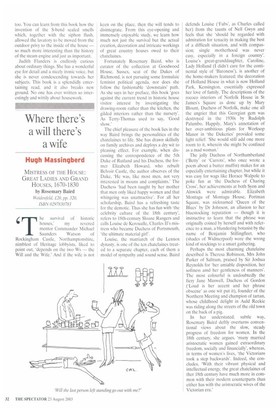The daily round, the common task
Jane Ridley
THE VICTORIAN HOUSE by Judith Flanders HaiperCollins, £20, pp. 476, ISBN 000713887 Today we tend to see the Victorian woman as a bird in a gilded cage, lying on a settee suffering from mysterious complaints such as neuralgia and pining away in genteel idleness. In this absorbing book, Judith Flanders nails that myth for good and all. Victorian women, she writes, 'did all the things that it is now thought genteel women didn't do'. They fought an exhausting, never-ending war against dirt, grease and coal dust, against bedbugs, cockroaches, illness and waste. But (rather like us) they never talked or wrote about the time they spent doing housework. No one has really considered it worth writing about either — not until this book, which tells you in fascinating detail all the things you wondered about the Victorians and didn't like to ask.
Judith Flanders has organised her book around the rooms of the Victorian terraced house, Each chapter is an essay which explores the functions, the furnishings and the life that went on in a single room — the bedroom, the nursery. the dining room, the scullery and so on. Flanders engagingly explains. 'It has been suggested that I am more interested in Sbends than I am in sex. For the purposes of social history this is so.' Her chapter on bedrooms, for instance, is silent about sex (phew, that's a relief) but tells you all you need to know about bedding and childbirth and how to get rid of the bedbugs that infested stuffy beds.
For Victorian middle-class women, appearances and status counted more than anything. There were certain ideals which must be lived up to — notably prioritising the relationship with the husband (in contrast with the child-centred family of today). Mrs Beeton thought that babies who shared the marital bed were 'vampires' who sucked their mothers' vital strength. The nursery was the space which testified to the family's success in distancing children from parents. Here manslaughter was rife. Teething babies were fed unsuitable foods which caused indigestion, and this was doped with opium-based 'medicine' such as Collis Browne's Chlorodyne (much sought after by 1970s hippies). This in turn induced 'convulsions' and the baby died. The nursery was also the place where girls were confined in isolation until late adolescence. The idea was not to educate them but to protect them from brain-strain and shelter them from stressful competition, and the result was that when they left home to marry they knew almost nothing about the adult world.
Having servants was the definition of being middle-class, much as consumer durables define status today. Middle-class families could often only afford one servant. and Judith Flanders gives a horrifying picture of drudges labouring on repetitive, back-breaking tasks from 6 a.m. until 10 at night. The maid was expected to clean the grates, black the kitchen range, whiten the doorstep, scrub the floors, purge cockroaches with carbolic and prepare meals. On Mondays she got up two hours early to do the laundry, a herculean ordeal of boiling, rubbing, wringing and mangling. After all this the maid would go to bed on the kitchen floor. The middle classes thought this was acceptable because they saw their working-class servants as another race, who were far tougher than their employers but basically untrustworthy and always liable to eavesdrop or pilfer or drink.
But middle-class women worked too.
They might pretend to be idle, spending their time making useless objects. But most of them cooked and sewed and shopped and cleaned, Mrs Beeton's recipes were actually written for the convenience of a woman who cooked herself, not for someone ordering a cook. And what meals they did create! Dinner a la francaise was as follows: first course of both fish and soup, second course of roast joint and roast fowl with side dishes of sweetbreads, kidneys or cutlets, third course of jellies and trifles with fruit and cheese to finish. Not that they ate all this — you would pick and choose, rather like a modern buffet. Victorians ate few vegetables. In fact, Flanders makes it sound as if they were permanently on a high-protein Atkins diet; one thing I would have liked to know was how they dealt with constipation.
This book is stuffed full of plums. You can discover here exactly how tight Victorian women laced their corsets, and how they bought ready-made, badly fitting bodices for their dresses and sewed the skirts themselves. By 1900 a fashionable woman was carrying 37 pounds of clothing. No wonder exercise was a problem. Flanders details the rules and grades of mourning, from the bombazine or crepe worn by widows in full mourning to the black sealing wax used to mark a distant death. She has researched the lavatory
too. You can learn from this book how the invention of the S-bend sealed smells which, together with the siphon flush, allowed the lavatory to be moved from the outdoor privy to the inside of the house — so much more interesting than the history of the steam engine and just as important.
Judith Flanders is endlessly curious about ordinary things. She has a wonderful eye for detail and a nicely ironic voice, but she is never condescending towards her subjects. This book is a splendidly entertaining read, and it also breaks new ground. No one has ever written so interestingly and wittily about housework.



























































 Previous page
Previous page